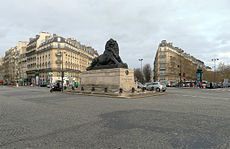Place Denfert-Rochereau

The lion of Belfort in the
Place Denfert-Rochereau |
|
| Length | 220 m (720 ft) |
|---|---|
| Width | 145 m (476 ft) |
| Arrondissement | XIV |
| Quarter | Montparnasse Petit Montrouge |
| Construction | |
| Completion | 1863 |
| Denomination | 1879 |
Place Denfert-Rochereau, previously known as Place d'Enfer, is a public square located in the 14th arrondissement of Paris, France, in the Montparnasse district, at the intersection of the boulevards Raspail, Arago, and Saint-Jacques, and the avenues René Coty, Général Leclerc, and Denfert-Rochereau[], as well as the streets Froidevaux, Victor-Considérant and de Grancey. It is one of the largest and most important squares on the left bank of the Seine.
The square is named after Pierre Denfert-Rochereau, the French commander who organized the defense at the siege of Belfort during the Franco-Prussian War (1870–1871). It is dominated by the Lion of Belfort statue (a smaller version of the original in the town of Belfort) by Frédéric Bartholdi.
The square is the location of the Paris Catacombs museum. It is frequently the place where demonstrations and protest marches in Paris either start or end. The square is also the place depicted on the backdrop at the beginning of the third act of La Bohème by Puccini.
This place owes its original official recognition to letters patent dated 9 August 1760, which applied to the part of the site that was located inside the old Wall of the Farmers-General, i.e., the northeastern portion of the present Place Denfert-Rochereau. (The Wall of the Farmers-General, built under the ancien régime to prevent the evasion of excise taxes, separated Paris from the suburb of Montrouge.) An ordinance of the Bureau of Finances, dated 16 January 1789, recognized the southwestern portion of the place, the part outside the wall, as part of Paris. The opening in the wall itself, which permitted entry or exit from Paris, was commonly called the Barrière d’Enfer. It is mentioned in Les Misérables by Victor Hugo:
...
Wikipedia

